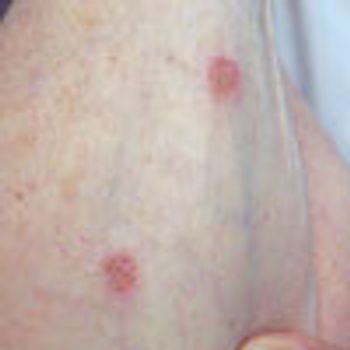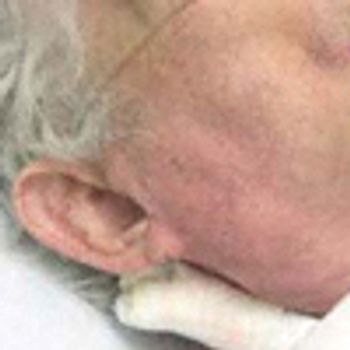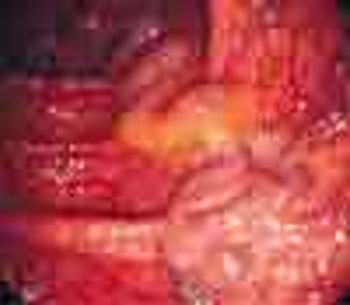
HOLLYWOOD, Fla. -- Without any fanfare or intention, the use of some drugs for high blood pressure may be silently protecting against Alzheimer's disease, suggest in vitro and animal studies presented here today.

HOLLYWOOD, Fla. -- Without any fanfare or intention, the use of some drugs for high blood pressure may be silently protecting against Alzheimer's disease, suggest in vitro and animal studies presented here today.

An 81-year-old woman presented with a widespread pruritic eruption of 1 month's duration. She had hypertension but was otherwise healthy and was taking no new medications.

SAN DIEGO -- High blood pressure during pregnancy may be a warning sign for stroke or other cardiovascular events later in life, reported researchers here.

ROCHESTER, Minn. -- Mortality rates for heart failure patients with preserved left ventricular ejection fraction (non-systolic) are similar to those for patients with a reduced ejection fraction (systolic). However, a higher systolic pressure on admission was a marker of better prognosis.

WINSTON-SALEM, N.C. -- High serum levels of uric acid are strongly associated with risk for hypertension, particularly among blacks, reported researchers here.

Abstract: Our understanding of the pathobiology of pulmonary arterial hypertension (PAH) has evolved considerably over the past 2 decades, with increasing recognition of the important role that aberrant vasoproliferative responses play in conjunction with disordered vasoconstriction. Classification of the many forms of PAH into categories sharing a similar pathophysiology and clinical presentations help the practicing clinician approach a complex differential diagnosis. Noninvasive tests can be used to narrow this differential but must be applied with an appreciation for their limitations. Transthoracic echocardiography is the screening tool of choice; the workup should also include chest radiography and electrocardiography. However, right heart catheterization is ultimately required to establish the diagnosis. While PAH remains a progressive and generally fatal disease, existing therapies have a significant impact on survival and new therapeutic targets offer great hope for improving the prognosis. (J Respir Dis. 2006;27(11):487-493)

An 84-year-old man with a history of stable angina, type 2 diabetes, hyperlipidemia, and hypertension presents to the emergency department with worsening dyspnea and peripheral edema.

An asymptomatic loss of pigment around the eyelids of several weeks' duration prompts a 53-year-old woman to seek evaluation. She has not started wearing any new eye makeup; her only medication is an antihypertensive.

SAN ANTONIO -- Children with high blood pressure are more likely to snore and have other sleep disordered breathing problems than normotensive peers, researchers reported here.

A previously healthy 56-year-old woman presented to her primary care physician with progressive dyspnea and pleuritic chest pain. She was afebrile and had a heart rate of 83 beats per minute, blood pressure of 104/70 mm Hg, and respiration rate of 20 breaths per minute. Her oxygen saturation was 87% on room air and 92% while receiving 3 L of oxygen via nasal cannulae.

Q: What is the lowest acceptable diastolic blood pressure (DBP) in a patient with systolic hypertension who is older than 65 years?

What is the lowest acceptable diastolic blood pressure (DBP) in a patient with systolic hypertension who is older than 65 years?

An 87-year-old woman complained of a red tinge in the vision of her right eye. She also felt that the vision in the right eye was just not right. She was pseudophakic in both eyes from previous cataract surgery. She had diet-controlled diabetes and took atenolol for hypertension.

Acute parotiditis is characterized by unilateral swelling of the parotid gland with associated erythema and tenderness. Purulent secretions from the Stensen duct may be noted in more than 50% of the cases.

COPENHAGEN -- The ACE-inhibitor Altace (ramipril) does not prevent type 2 diabetes in patients with impaired glucose metabolism, found DREAM trial researchers.

COPENHAGEN -- The ACE-inhibitor Altace (ramipril) does not prevent type 2 diabetes in patients with impaired glucose metabolism, found DREAM trial researchers.

ABSTRACT: Our knowledge of chronic diseases has advanced significantly in recent decades, but patient outcomes have not kept pace. This is largely because the traditional acute care model does not adequately address the needs of patients with chronic disease. Patients play an active role in the management of chronic disease, and successful outcomes are highly dependent on adherence to treatment. Thus, clinicians need to have skills in coaching and encouraging as well as an awareness of factors in patients' backgrounds that are likely to affect their ability or willingness to follow treatment plans. Provider- and system-related factors, such as lack of reimbursement for counseling and high copayments, can also act as barriers to compliance. Among the strategies that can improve adherence are the use of community resources, multidisciplinary approaches, and regular follow-up.

The term "prehypertension" was introduced in the Seventh Report of the Joint National Committee on Prevention, Detection, Evaluation, and Treatment of High Blood Pressure (JNC 7) guidelines to describe blood pressures (BPs) of 120/80 mm Hg to 139/89 mm Hg.1

A 64-year-old woman presents with persistent, progressively worsening chest pain and dyspnea of 1 month's duration. She also reports orthopnea, bilateral leg swelling, and weight gain. She denies any history of similar symptoms.

Over the past few decades, the management of chronic disease has assumed a greater role in health care. Diseases such as diabetes, chronic obstructive pulmonary disease, and depression have replaced acute disorders as the leading cause of morbidity, mortality, and health care expenditures.

Should patients with prehypertension be treated with antihypertensive drugs?

A 64-year-old woman presents with persistent, progressively worsening chest pain and dyspnea of 1 month's duration. She also reports orthopnea, bilateral leg swelling, and weight gain. She denies any history of similar symptoms.

A 50-year-old man with alcohol-induced cirrhosis was hospitalized with lower GI bleeding. On examination, he was pale, heart rate was 100 beats per minute, and blood pressure was 100/60 mm Hg. He was anemic (hemoglobin level, 9 g/dL) and thrombocytopenic (platelet count, 112,000/µL).

IRVINE, Calif. -- Too much work is mirrored in high sphygmometer readings, according to a survey of those who toil in California.

CHICAGO -- High blood pressure appears to impair older patients' ability to walk, and the reason may be more than just peripheral arterial disease.